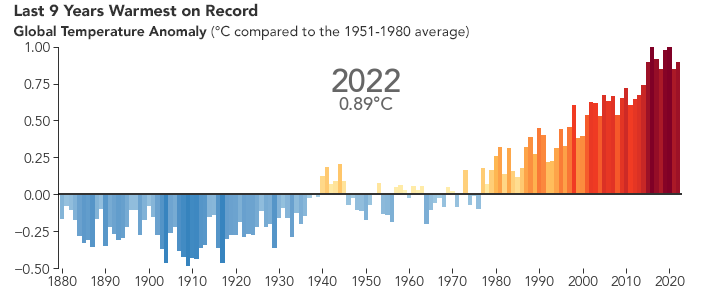 My final post in 2023 was about growth curves. It focused on the difference between geometric growth versus exponential growth — which turns out to be not much — and compared them to polynomial growth (see that post for the math-y details; this post isn’t a math post, so relax and read on).
My final post in 2023 was about growth curves. It focused on the difference between geometric growth versus exponential growth — which turns out to be not much — and compared them to polynomial growth (see that post for the math-y details; this post isn’t a math post, so relax and read on).
A key characteristic of all these growth curves is that they grow without limit. If we treat the horizontal axis as time, then the longer the growth continues along the curve, the greater whatever growing grows.
The problem is that nothing in the real world can grow infinitely without limit. At some point, something has to give.
To the ancients, the world seemed limitless, but the modern world faces many limiting factors. With a global population that recently reached eight billion (with no sign of stopping), we are challenged by our constant expansion. For the first time in our history as a species, we face the questions of “How can this continue?” and “What’s going to happen next?”
Yet, as with all forms of life, growth seems part and parcel of existence. It’s part of what made us such a successful species, but now it threatens our existence (or, at the least, the quality of that existence).
One example concerns the amount of carbon dioxide (CO2) the modern world has pumped into the atmosphere and the resultant warming of the planet from the greenhouse effect. And while this isn’t a post about global warming (so relax and read on), one of the best — and most interesting — illustrations of the problem is this xkcd diagram. I highly recommend you take a moment to view it and be sure to scroll all the way to the bottom for the punchline.
Or you can just consider this chart from NASA’s Earth Observatory:
The only other thing I’ll say about global warming is that here in Minnesota — formerly famous for its chilly winters — our February has been absolutely insane. Here’s a chart of our high and low temperatures in what is usually one of the colder months of winter:

The horizontal black line is 32° (Fahrenheit), and you can see that we spent a lot of time above that line. The lowest temp we saw (during a nasty cold snap just yesterday) was 4° above zero. Usually in February we expect to see temperatures with minus signs, but there have been none this month. The average high was 42.6° and the average low was 24.6° — very, very weird!
Of all the growth curves that demand our attention, this should be number one. Most experts think we’ve already gone too far to prevent what amounts to a global disaster, and we don’t seem to have the political will to really address the problem. Thing are going to get ugly in the near future for a lot of people.
[Sometimes I’m glad I’m old enough that I won’t have to see it.]
§
But my main point is much broader than the pending climate disaster. What inspired this Brain Bubble was our general obsession with growth. It’s something that’s bugged me since I was in high school (a time now almost too distant to remember clearly).
In the business world there is a perception that not only can you not slow down, but you can’t even stand still. You must be ever and always moving upwards and onwards. A business, whether a big corporation or a single individual, must constantly expand. Apparently, it’s not okay for a business to achieve a steady state turning a decent profit each year. No, each year must see greater profits and expansion.
I’ve never understood that. If I had a business that was doing well — making an acceptable profit, maintaining a customer base — I’d be happy to just let it be. Trying to expand just leads to big loans and headaches.
And clearly that sort of thing can’t go on forever. Growth curves in the real world must always do one of two things: level out (in what’s sometimes called an “S” curve) or break down somewhere.

An example of an “S” curve (called a sigmoid function).
The Growth Paradigm left unchecked leads us down a bad path. We need, as a species, to learn to level off, to accept “enough” as an answer.
There is a Yin-Yang situation here. Progress is good, but infinite growth isn’t possible, and that latter fact should factor into our thinking more often.
§
A corollary to the Growth Paradigm — one that has especially bugged me — is the perception that anything less than maximum profit is a loss. As with a steady state, failing to squeeze every bit of possible blood from your customers is seen as a business fail.
[And don’t get me started on Wall Street and the stock market. I think shareholders, when they’re not actual employees, are one of the worst things to happen to business and one of the big drivers in obsessive growth and profit maximizing. If I were in charge, the stock market would be history. If a business needs money to expand (and I’d put severe limits on that), they can get a load from a bank.]
§
Our world is filled with runaway growth: CO2 in the atmosphere, the resulting global warming, population at eight billion and growing, epidemics, wealth disparity, technology, and even viral memes.
It was one secret to our success, but (as is often the case) it has a dark side, too.
Stay steady, my friends! Go forth and spread beauty and light.
∇














February 29th, 2024 at 10:20 am
For the mathematically curious, here’s one formula for a sigmoid curve:
February 29th, 2024 at 10:31 am
That snowfall we got mid-month is almost completely gone now. (Remember this?) Truly the weirdest February I can recall!
February 29th, 2024 at 10:41 am
Here’s a radical solution” Kohei Saito, a Japanese economist, has written a “Slow Down: The Degrowth Manifesto.” In short, it’s an argument that modern capitalism simply cannot solve these problems. It’s on my current reading list. I just haven’t gotten to it yet. But your essay inspired me to move it up a bit.
February 29th, 2024 at 11:02 am
Yeah, unfettered capitalism is utterly unsustainable in my eyes. The whole notion of unlimited growth is mathematically untenable, but even in the early stages the wealth disparity it creates isn’t good for us.
But so long as we worship the Almighty Dollar and continue to act like bacteria in a rich Petrie dish, we’re doomed. It makes me laugh when I hear those hopeful discussions about humanity millions of years (let alone billions) from now.
March 1st, 2024 at 6:23 am
Yes, why is GDP the metric of happiness in our society?
March 1st, 2024 at 9:19 am
I was raised by non-materialistic church folk, so that’s something I’ve never grasped intuitively. I suppose it’s because it’s an ancient, obvious, and easy metric. And humans often tend to be materialistic, if not downright greedy. Mine, mine, mine!
March 1st, 2024 at 12:27 pm
It seems like being able to hold a business steady should be seen as a good thing. Infinite growth is a preposterous model.
March 1st, 2024 at 2:26 pm
Yes, and yes! It seems as if part of the human condition is the notion that “enough” is a bit foreign to us.